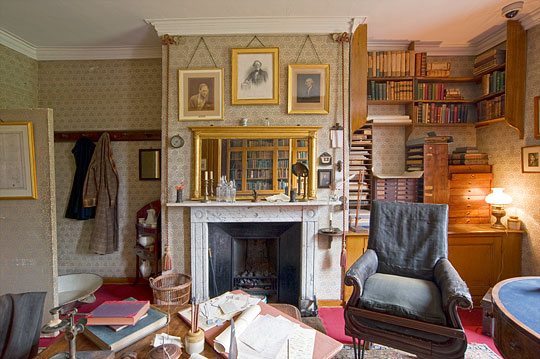Significance of Down House
Interest in Darwin’s life and work continues to grow. His groundbreaking theory of evolution is an accepted part of our understanding of the world and remains at the heart of scientific thought. Down House is important because it was here that Darwin undertook much of the research and experimentation that underpinned his scientific thinking, and much of what he saw then can still be seen and understood by visitors to Down House today.

Darwin’s Study
Much of the significance of the house lies in the authenticity of the rooms, of which Darwin’s Old Study is the best example. The room as it is seen today remains structurally unaltered from Darwin’s time. It was restored to the original 1870s arrangement and decoration in 1929, based on a detailed photograph taken in the 1870s together with information from Darwin’s surviving son, Leonard (1850–1943).
The wallpaper and fixtures of that early recreation have been preserved, and the room contains almost every original piece of furniture and dozens of Darwin’s possessions, including some dating from his time on HMS Beagle.
Darwin’s Garden
The greenhouses today are stocked with the same plant specimens that Darwin cultivated for his botanical research projects, many of which stemmed from subjects that had first pricked his interest elsewhere.
As an undergraduate at Cambridge, for example, Darwin had studied the reproductive biology of orchids. He then collected rare specimens during his voyage on HMS Beagle.
Among the critical findings that stemmed from his research in the gardens at Down House was that diverse and beautiful forms of different species of orchid have evolved to attract specific insect pollinators.
The results of his research were published in 1862 in On the Various Contrivances by which British and Foreign Orchids are Fertilised by Insects, which made a major contribution to the study of orchid anatomy and plant reproduction.
Circumnutation and Insectivorous Plants
Darwin’s next work, On the Movements and Habits of Climbing Plants (1865), developed from his examination of certain climbing-plant species that he had grown in pots in the greenhouse and winding through the trelliswork fixed to the back of the house.
By dedicated observation and copious note-taking Darwin was able to detect what he called circumnutation – the gyrating movements of the plant stems as they searched for support on their upward climb. He noted their responsiveness to different light conditions, exploring the notion that plants ‘sleep’ in darkness.
Another important area of research Darwin carried out in the gardens at Down House was on insectivorous plants, in particular a sundew Drosera rotundifolia, which he had first spotted in Sussex in 1860.
Darwin cultivated dozens of specimens in terracotta pots on his greenhouse benches, noted the gradual curling of the Drosera’s sticky tentacles around an unsuspecting fly or gnat, and fed his plant specimens specks of raw meat, egg white and even nail clippings.
The illustrations in the resulting work, Insectivorous Plants (1875), show the relationship between insect and plant predator that he observed in the greenhouses at Down.
READ MORE ABOUT DOWN HOUSE